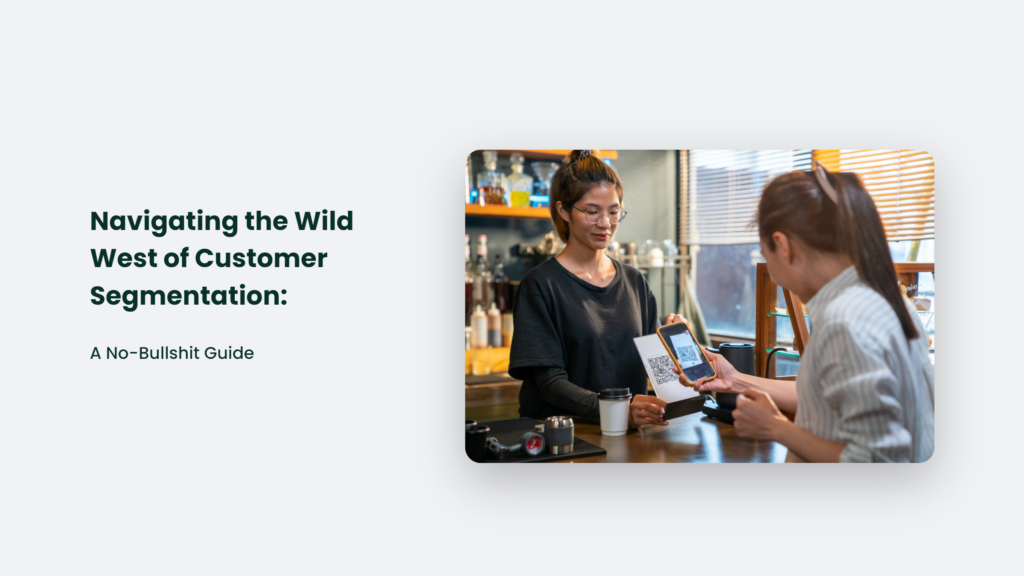Well, look at you, savvy business owner. You’ve probably heard this buzzword flying around more times than you can count: Customer Segmentation. But, despite its overuse, you’re still scratching your head thinking, “What the hell does it really mean?” and “Why should I care?”
Sure, it sounds as exciting as watching paint dry, but hear me out. Customer segmentation is not just some fad.
It’s a rock-solid foundation on which you can build your marketing castle. But hey, if you want to shoot yourself in the foot, be my guest, skip this and continue with your one-size-fits-all marketing strategy. Let’s dive in for those of you who have a semblance of sanity.

The What and Why of Customer Segmentation
Here’s the straight-up truth: Not all customers are created equal. Some are loyalists, ready to tattoo your brand logo on their forearms, while others wouldn’t piss on your products if they were on fire.
It, my friends, is where customer segmentation saunters into the picture, like a cowboy swaggering into a saloon. It’s about splitting your customers into groups based on age, gender, interests, and purchasing behaviour.
Why? Because you can’t sell a vegan a steak, and you can’t convince a toddler to buy a lawnmower.
The Delightful Dance of Data
Segmentation is as much an art as it is a science. It’s a delicate dance that begins with a deep dive into your customer data. For the sake of simplification, I’m going to talk about four major types of segmentation:
- Demographic Segmentation: This is like picking your friends based on their hair colour. Think age, gender, income, etc. It sounds shallow, but sometimes it works.
- Geographic Segmentation: This one’s about location. You wouldn’t sell an Eskimo an ice cube, would you?
- Psychographic Segmentation: This delves deeper into the dark abyss of customers’ minds. It’s about their interests, hobbies, lifestyle, etc.
- Behavioural Segmentation: This is about how customers act. It’s like being a private investigator but less creepy and more profitable.
Understanding these categories is only half the battle won. The real fun (and by fun, I mean slightly less boring) part begins when you start implementing them.
The Intricate Waltz of Implementation
You’ve got the four types of segmentation, right? Demographic, geographic, psychographic, and behavioural. How do you turn these fancy words into a functioning, money-making strategy? Here’s a step-by-step guide to keep you from tripping over your own feet in this delightful dance.
Step 1: Know Thy Data
Your customer data is your dance partner in this waltz. The better you know your partner, the smoother your dance will be. Start with the basics: names, ages, and locations. Then dig deeper: buying habits, interests, complaints. It is your chance to play Sherlock Holmes, minus the cool hat and the nicotine addiction.
Step 2: Slice and Dice
Once you’ve gathered all the necessary data, it’s time to carve it up like a Thanksgiving turkey. It is where our four types of segmentation come into play.
Demographic data can be sliced by age, gender, income, and so on. Geographic data can be divided by city, country, or even neighbourhood. Interests, lifestyles, and values can segment psychographic data. And behavioural data can be split based on buying habits, brand interactions, and product usage.
Step 3: Tailor Your Approach
Now, imagine you’re at a party. You wouldn’t tell the same joke to your grandmother that you would to your college roommate, right? This is where tailoring comes in. You’ll need to craft a marketing strategy for each segment that resonates with them.
For instance, if you’re selling a new energy drink, your marketing message for the young, athletic demographic will be wildly different from the one for the middle-aged, health-conscious demographic.
Step 4: Test, Tweak, Repeat
Just because you’ve segmented your customers and tailored your marketing doesn’t mean your work is done. No, sir. You need to monitor, test, and tweak your strategies based on the feedback and results you get. This step is like the continual practice sessions that keep the dance performance polished.
And there you have it. The delightful dance of implementing customer segmentation. It’s not an easy two-step, but once you get the hang of it, you’ll be twirling your way to customer satisfaction and increased profits.
Now, let’s get those dancing shoes on and start waltzing!
Customer Segmentation: The Good, The Bad, The Ugly, and The Statistically Proven
Now, I’m not just blowing smoke here. Some solid numbers back up this segmentation spiel.
- A whopping 77% of the returns generated through email marketing come from audience segmentation, targeted, and triggered campaigns.
- Retail brands that broadcast personalized promotional emails experience a 46% higher email open rate and a 27% higher click-through rate than regular marketing emails.
- Retail brands can score 3-5% more sales through campaigns tailored to different audience segments.
- 80% of customers are likelier to buy from a brand that tailors the experience for them.
- At least 49% of consumers agreed to buy a product impulsively when they came across a personalized offer.
- 51% of customers want retail brands to anticipate their needs and contact them with a suitable offer.
Impressive, right? But, let’s face it, no approach is without its challenges. There’s a whole Pandora’s box regarding customer segmentation:
- Data privacy issues
- The cost of implementing segmentation
- The risk of over-segmentation
But then again, what’s life without a few challenges? If business was easy, we’d all be sipping margaritas on a beach somewhere instead of figuring out how to sell more stuff.
The Art and Science of Implementing Customer Segmentation
Now, implementing customer segmentation is like training a stubborn puppy. It requires patience, persistence, and a good amount of treats (in this case, data).
Here’s a rough roadmap to get you started:
- Collect Data: This is the ‘treats’ part. The more data you have about your customers, the better.
- Analyze: This is where you play detective and uncover patterns and trends in your data.
- Segment: Slice and dice your customer base into distinct groups.
- Target: Develop targeted marketing strategies for each segment.
- Measure: Keep track of your results and adjust your strategies as needed.
Remember, it’s not a one-size-fits-all approach. What works for one business might not work for another. It’s a journey of trial and error, and a hell lot of persistence.
Frequently Asked Questions:
How often should I update my customer segments?
As often as you change your underwear, ideally. Customer preferences can change over time, so it’s important to keep your segments updated.
Is customer segmentation only for big businesses?
Hell no! Even if you’re a one-man show, understanding your customers can give you a competitive edge.
Final Thoughts:
To wrap this up, remember that the ultimate goal of customer segmentation is to understand your customers better, so you can provide them with a tailored experience. It’s not a magic bullet but a damn good starting point.
So go forth, brave business owner. Use the power of customer segmentation to ride off into the sunset of business success. And remember, in the wild west of customer segmentation, it’s not the biggest or the fastest that wins; it’s the one who knows their customers best.




